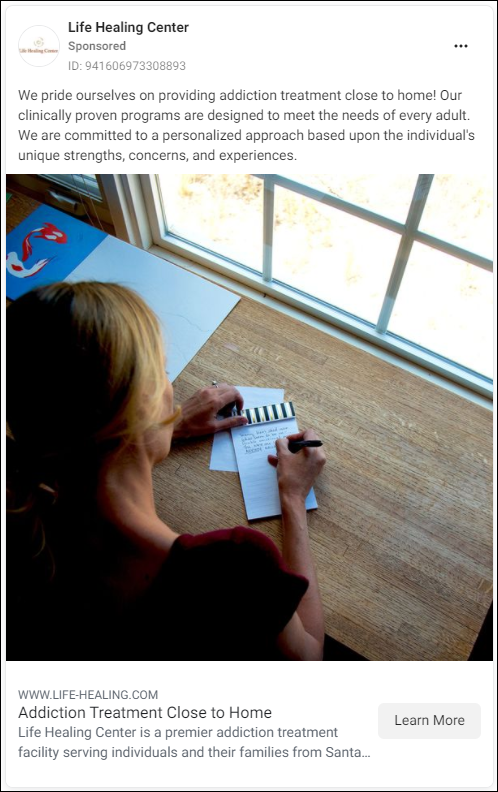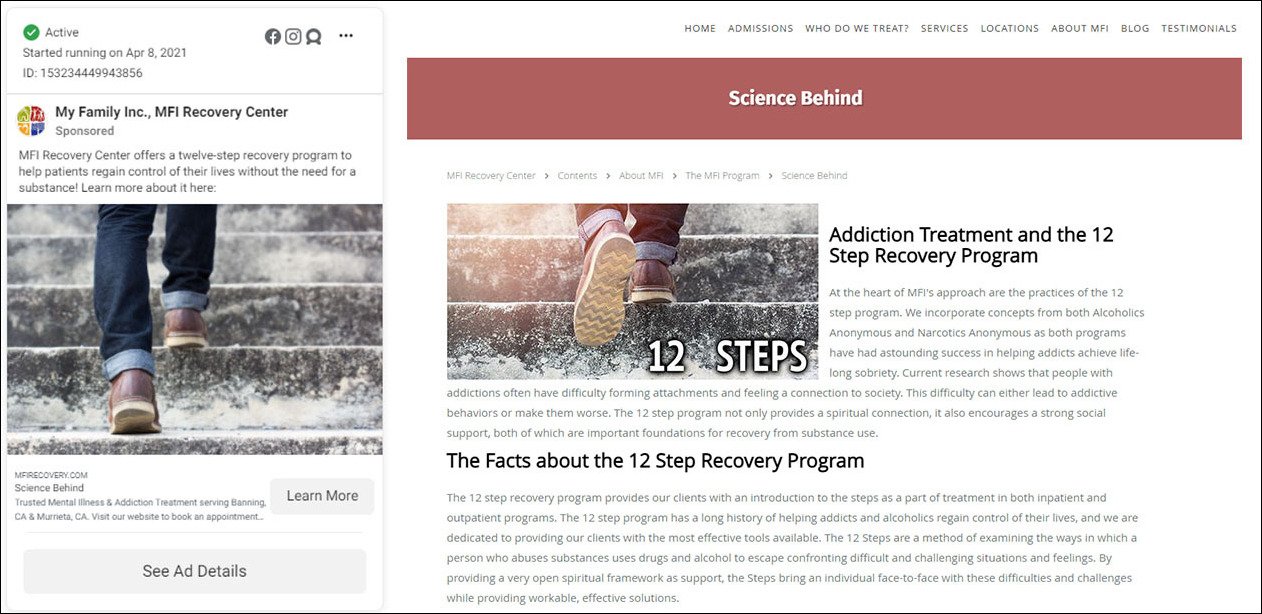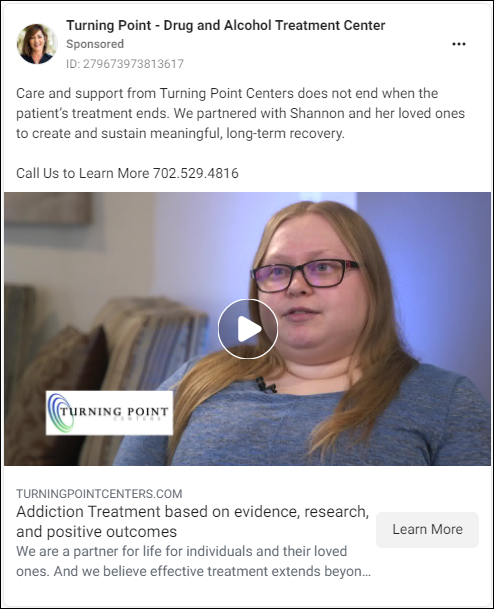To help people in the digital era, you need to be able to reach them online. One of the best ways to do so is through social media and, more specifically, Facebook. With its 2.7 billion monthly active users, Facebook is an absolute juggernaut. For addiction centers, this platform—and Facebook Ads, specifically—is a perfectly viable way to maximize your center’s reach, build brand awareness, and nurture prospects until they’re ready to seek help.
Of course, there are several ways to reach more people with social media advertising, whether starting from scratch or working with existing campaigns. Here are seven strategies we use to help addiction centers build and optimize their Facebook Ads campaigns.
Did you know? In 2019, Facebook announced that only addiction treatment centers verified by LegitScript are permitted to advertise on Facebook. Is your center verified?
1. Invest in Great Ad Creative
Let’s start with a reality check: there are a lot of rehab centers in the world. Heck, there are a lot of rehab centers within 50 square miles of where you’re standing right now. This means the digital advertising landscape is similarly crowded. How will you set yourself apart? How will you compete for eyes, clicks, and conversions?
Start with a critical look at your ad creative. To capture people’s attention amidst all the digital noise, your ads needs to shine in two particular areas:
The Words (Ad Copywriting)
The headlines, ad copy, CTA language, and other copy points you deploy are crucial to the success of Facebook Ads—and they’re too often overlooked. In our experience, you shouldn’t leave the ad messaging to the end or as an afterthought. Prioritize getting the messaging right, and you’ll develop better ads that resonate with your target audience.
Our advice? Bring in your ad copywriter (in-house or external) early in the campaign conceptualization phase. Invite them to collaborate with other stakeholders on the campaign, including ad specialists, social media managers, and graphic designers. The more context your writers have about the audience, featured service, and objective, the better.
Pro tip: Similar to Responsive Search Ads (RSAs), the Multiple Text Options allows you to load up a total of five copy variations for headline, text, and description, then leave it to Facebook to “show different combinations of text to different people based on what they’re more likely to respond to.”

The Pictures (Graphic Design)
Reread the first paragraph in the previous copywriting section, but swap out ad copy for graphic design and copywriter for graphic designer. The same rules apply in terms of when and how to think about your ad design: early and often.
Today, people have developed a kind of ad blindness. There’s so much competition, repetition, a sheer volume of ads—across all social media platforms—that it often takes bold, original imagery and photos to breakthrough. Stock photos are almost always a no-no in this regard. And the very best Facebook Ads, at least in our view, achieve a kind of synergy between writing and design.
Pro tip: In both areas of ad creative, two guiding principles will serve you well: be authentic and use strong CTAs. Your ads aren’t just there to sound good and look pretty. They’re there to compel people to take action (some of whom happen to need serious help).
2. Refine Your Ad Messaging
Because the ad messaging you use is so important, we thought we’d elaborate on some ways to further refine it (beyond hiring a stellar copywriter). Here are four activities that can dial in ad messaging and enhance its potency:
- Conduct interviews with rehab center patients to understand how they found care, what they were seeking, and so on. This language can be rich with potential ad material.
- Create detailed buyer personas based on accurate data and research, and have stakeholder approval beyond the marketing team, then formalize them so that these personas have organization-wide visibility.
- Be empathetic in how you position your brand and services. People seeking addiction care—and their families—want to know they’re working with someone they can trust and a team that gets it.
- Test various messaging themes to understand what resonates and what doesn’t with people considering rehab. The data doesn’t lie!
3. Create Mobile-First Ad Content
Keeping audience attention on mobile platforms is a big deal for Facebook and the addiction centers that are advertising on it. In 2019, Facebook hit the $15.6 billion mark for mobile ad revenue. That’s a whopping 94 percent of the total ad revenue. Guess where Facebook focuses most of its energy?
The same goes for addiction centers. And while it’s a big intimidating pie to try to get a piece of, it would be a critical mistake for addiction centers to neglect mobile Facebook advertising. As the numbers show, mobile is where your audience is.
Now, when we talk about mobile Facebook ads, we don’t simply mean repurposing your existing desktop ads for mobile audiences. Not everything that looks great on your desktop works for mobile, anyway! On the contrary, we mean creating mobile-first content—images, video, copy, and other content—from the ground up. That means focusing on:
- Quicker-hit written assets (few people are reading 30-page whitepapers on their iPhones).
- Image and media-rich click-through content (for example, can that blog post be converted to a digestible, mobile-friendly infographic?)
- Larger font sizes for ad graphics make life easier for people viewing the ad on smaller screens.
- Vertical format for video so that your ads make the most of limited mobile screen real estate.
- Mobile-optimized landing pages that load fast, feature responsive layout, and make it easy to take action (click, call, register, etc.) from a mobile device.
Pro tip: For a more comprehensive guide to mobile UX and marketing, see Healthcare Marketing for a Mobile-First World.
4. Develop Custom Landing Pages Aligned with Each Ad Campaign
Reality check: your rehab center might have the most thoughtful homepage in the world, but it’s probably not the best destination for your Facebook Ads. While pointing to your homepage isn’t going to land you in hot water by way of Facebook Ad Policy, it might weaken the continuity between campaign creative and click-through. This can only hurt your engagement, click-through, and conversion rates.
Instead, take the time to develop landing pages that:
- Align with your ad targeting and messaging
- Provide ALL of the information your target audience wants
In the world of addiction centers, this might include a specific course overview, introductions to your providers, and patient or alumni testimonials. Most people looking for chemical dependency rehabilitation wonder about cost and insurance, so you must include that too. Adding a frequently asked questions (FAQ) section ensures that no doubt is left in the patient’s mind. Finally, use a couple of strong CTAs that encourage that next step, be it scheduling a consultation or simply filling out the contact form.
All of this content should be optimized for the specific campaign, audience, program, and so on. For example, you might have dedicated landing pages for:
- Patient-oriented versus family-member-oriented campaigns
- Different types of substance abuse
- Program type (in-patient versus out-patient, for example)
The point is, the target audiences within each of these buckets will have different questions, needs, and hangups. The more personalized your landing page experience is for each, the better your Facebook ads will perform.

5. Use Video in Your Facebook Ads
We mentioned the importance of mobile-first ads. In the same vein, most indicators point to the growing prominence of video ads. Actually, most indicators point to the growing dominance of video. Just take a look at Facebook’s own tips for optimizing ad creative for mobile—most (if not all) of these tips are oriented toward some kind of video ad.
Even beyond Facebook, video is now favored by nearly all of “the algorithms” (search engines, Instagram feeds, and so on). It’s easy to consume and has higher engagement rates. And video is a fantastic medium for storytelling. For a rehab center, this kind of video ad might include:
- Brand storytelling that demonstrates what makes your rehab center different
- Tours of your facility (you can even make them interactive)
- Patient testimonials that address some of the fears and apprehension your target audience might be feeling
Think about what people considering rehab want to see when looking at providers. Is there a way to appeal to those needs with video? Doing so can make a world of difference in terms of ad performance.

6. Move Patients Toward Conversion With a Full-funnel Strategy
Seeking rehabilitation for chemical dependency and addiction isn’t like online shopping. The decision to seek care alone takes a long time (if it ever happens at all), and a commitment to a given provider is something that must be nurtured. This is where a full-funnel Facebook Ads strategy comes in.
When we say funnel, we mean from the beginning to the end of the patient journey—from awareness to consideration to conversion—that prospects move along. It’s different for each provider and industry, but the principles of a full-funnel ad strategy are generally the same:
- Show an ad to your target demographic audience
- Use the Facebook platform to identify who has engaged with the ad
- Create a second ad campaign that is displayed to those engaged users, with the goal of moving them toward a conversion
A simple example would be an ad that uses a video testimonial from a patient. You can configure your campaign to serve up a second ad only to those users who watched for 15 seconds or more. Ideally, this second ad builds on the first and moves that person farther along the journey toward contacting your center—an offer for a free consultation, maybe.
7. Test, Iterate, and Repeat
The most successful advertisers create baselines then constantly try to beat them. They don’t do so by making a single design, tagline, or campaign and then call it a day. Instead, they test different messaging against different audiences—constantly. They might look at how millennials respond to a benefits-oriented appeal vs. challenges-oriented vs. fears. They test photographs versus graphics or video ads vs. the use of still photographs.
Consider creating multiple variations to test different parts of your ad creative (messaging themes, keywords, etc.) and run split tests on those variations. The difference between what you think is working and what’s actually working is hiding in the data. You just have to test it. The good news is that split testing is built into the Facebook platform.
Finally, Optimize for What Makes You You
Branding is an essential competitive differentiator within the rehab space. Competition is stiff, and the audience you’re vying for has a different kind of need. Their needs require empathy, personality—a human feel if you will.
This is where the strength of your brand comes in. What makes your rehab center unique should extend to your Facebook Ads. It should permeate the media and messaging you use, and the programs you decide to build campaigns around. The decision to seek addiction treatment can be very fleeting. People who “convert” on your ads, visit your website, or even schedule an appointment might suddenly drop off.
Ad campaigns built on a strong, empathetic brand might be the very thing that gets them to come back.

